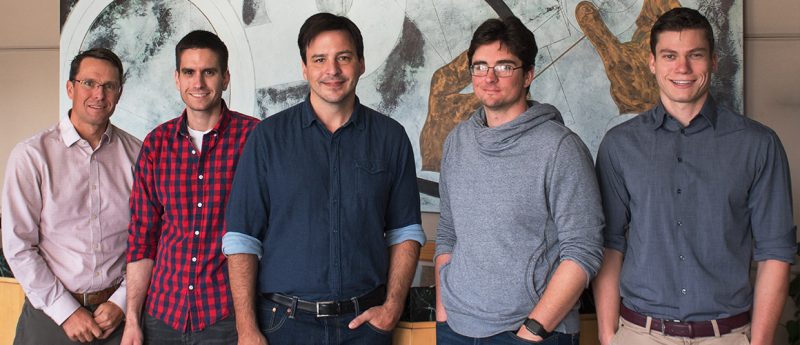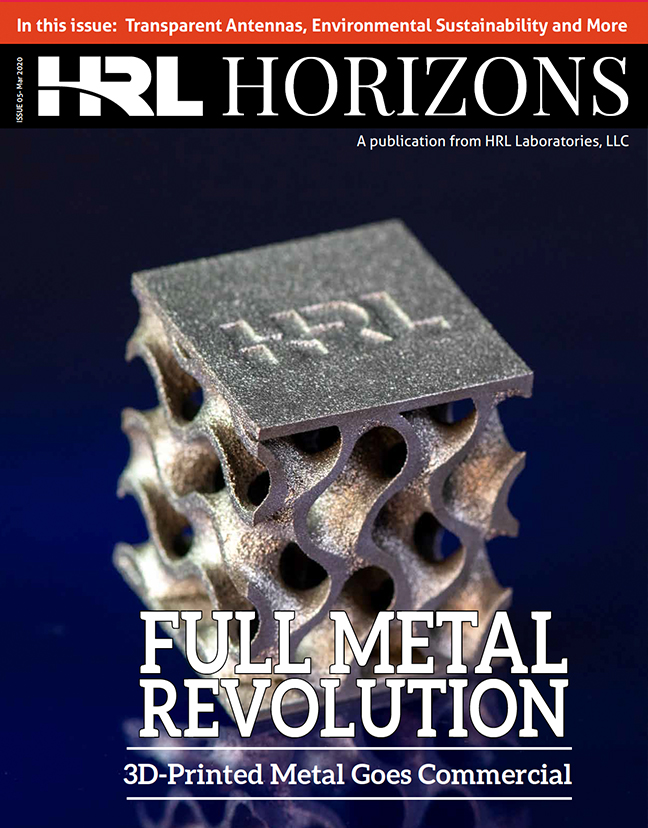
HRL Awarded DARPA Project AMEBA to Develop Man-Portable Low-Frequency Radio Antennas

The AMEBA Team (left to right): Geoffrey McKnight, Walter Wall, David Shahan, Casey Sennott, Skyler Selvin. © 2017 HRL Laboratories.
HRL Will Use Magnetoelastic Material for Antennas That Enable Communication Through Water or Ground
HRL Laboratories, LLC, has received an award to participate in project AMEBA, the Defense Advanced Research Project Agency (DARPA) initiative to develop low-frequency radio transmitters that are vastly more compact and efficient than the massive antennas used to communicate in traditionally radio-denied conditions.
Ultra-low frequency (ULF) signals have very large wavelengths that can penetrate areas usually prohibitive to radio signals such as within caves or underwater. Commonly used radio wave frequencies and radar bands do not penetrate water or the ground due to their electrical conductivity and in the case of the earth, iron ores that strongly attenuate radio signals.
While ULF wavelengths do not carry large amounts of data – typically short encoded messages – they could enable communication that is impossible with typical radio equipment, such as with divers, troops in caves or difficult terrain, or personnel housed underground.
“That’s why people trapped in mines must communicate with the surface by tapping on pipes, because typical radio communication cannot be used,” said Geoff McKnight, co-lead researcher on the project from HRL’s Sensors and Materials Laboratory.
Most radio frequency systems for consumer electronics, such as cell phones, operate in the billions of hertz – gigahertz – frequencies. The goal of the AMEBA project, which stands for A Mechanically Based Antenna, is to enable a communications system that transmits at less than a thousand hertz and is man-portable. This would enable communication deep underwater or underground, with the ease of a backpack-based system.
“For those people in mine disasters, or in buildings collapsed after earthquakes, a portable low-frequency beacon could also make a dramatic difference in search and rescue,” said Walter Wall, project co-lead from HRL’s Advanced Electromagnetics Laboratory.
“Typical antennas are physically sized to resonate with the electromagnetic wavelength, which is convenient for portable communications at common radio and cell phone bands with wavelengths of a meter or so. At ULF, the low frequency and the high speed of light combine to create a very long city-sized wavelength. HRL’s proposed antennas are also resonant, but use resonant acoustic waves, which travel about million times slower than radio waves, to dramatically shrink the antenna size, weight, and power,” McKnight said.
“Other teams working on this problem are attempting to achieve a low-frequency wave by taking a permanent magnet and rotating or oscillating it. The mechanical motion of that magnetic moment is equivalent to a traditional antenna, which achieves an oscillating magnetic moment by oscillating large amounts of electrical current,” McKnight said. “Our approach is different because instead of physically spinning a magnet, our device is magnetoelastic, meaning the magnetic field oscillates within the material in response to acoustic stress waves, created through structural vibrations.”
The HRL team’s antenna will use materials that possess a quality called magnetostriction. This enables the material to be magnetized just like iron, but unlike iron, when magnetized this material elongates. A reciprocal effect is that mechanical stress can be used to control the direction of the magnetization inside the material. By vibrating the material, elongating and compressing, the magnetic field oscillates within the antenna without physically spinning it.
“We’re just vibrating a stack of magnetic material and the magnetization is flipping back and forth in the material,” Wall said. “These elastic forces allow us to control the magnetism.”
One of the keys to transmitting communication with the antenna is the ability to modulate the signal frequency. A physically spinning antenna begins to act like a flywheel and store energy due to inertia. High inertia makes such devices inherently frequency-stable, in turn making signal frequencies very hard to modulate. Vibrating systems are also very stable, hence their use in clocks. But HRL recently discovered a mechanical way to rapidly shift the resonant frequency and the researchers propose to use that mechanism to rapidly modulate the transmitter frequency with relatively little electrical power.
“This is a pretty exotic project for us,” Wall said. “When you consider that most wireless devices operate at a billion cycles per second, this system will work at a thousand cycles per second. It is a part of the spectrum most people don’t think about much, but it is pushing HRL research in completely new directions, which is a nice thing as well.”
HRL Laboratories, LLC, Malibu, California (hrl.com) is a corporate research-and-development laboratory owned by The Boeing Company and General Motors specializing in research into sensors and materials, information and systems sciences, applied electromagnetics, and microelectronics. HRL provides custom research and development and performs additional R&D contract services for its LLC member companies, the U.S. government, and other commercial companies.
Media Inquiries: media[at]hrl.com, (310) 317-5000

